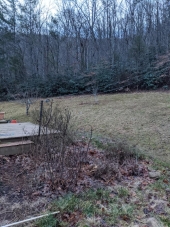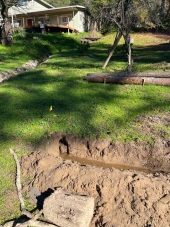
 3
3















This is all just my opinion based on a flawed memory









This is all just my opinion based on a flawed memory











This is all just my opinion based on a flawed memory

 2
2




-Nathanael
 2
2




This is all just my opinion based on a flawed memory





Particularly, just as mulch. I often lay down a thick layer of wood and branches and just plant into it.
So if your swales are, say 25 meters apart, have the sill drain diagonally into the opposite end of the next swale.
I would spread the berm out for the entire width of land between the two swales
Eucalyptus gets a bad rap because people will destroy the land by growing it in mono-culture, but in a forest ecology with abundant water, they are really an amazing resource for both mulch and building material.
Here we have large enough rain events (24" in a day back in 1964, 10" day in 2016) and so much deforested and hardscaped land that I would not do true swales (on contour). I just make the water meander around hugel beds that are almost entirely above the water table, with ponds catching that diverted water on its way. I will also fill any relatively straight standard (desertifying) drainage trenches with woody debris to make the water travel further in contact with biomass.




Bunbunan wrote:
Particularly, just as mulch. I often lay down a thick layer of wood and branches and just plant into it.
Yes, in syntropic agroforestry a concave raised bed with a thick layer of woody mulch is also the usual practice. But I'm worried in my situation it won't be enough to keep roots above the water table.
So if your swales are, say 25 meters apart, have the sill drain diagonally into the opposite end of the next swale.
I want to plant coffee in much more closely spaced rows, probably every 3 or 4 meters. If swales are placed this far apart, would you plant interswale rows on grade, or build mounds/ridges but without an accompanying ditch?
I would spread the berm out for the entire width of land between the two swales
Basically make terraces? This would require a lot of soil, and deep/wide swales.
-Nathanael
 1
1




 1
1




Iterations are fine, we don't have to be perfect
My 2nd Location:Florida HardinessZone:10 AHS:10 GDD:8500 Rainfall:2in/mth winter, 8in/mth summer, Soil:Sand pH8 Flat
 1
1




Come join me at www.peacockorchard.com




Bunbunan Situmorang wrote:
This article stresses that you shouldn't bury the woody debris inside the berm, but I don't think that's what you were suggesting. Rather, build a regular swale with berm, and then a low hugel on top of that for extra drainage, correct?
Come join me at www.peacockorchard.com

|
A wop bop a lu bop a womp bam boom! Tiny ad:
The new purple deck of permaculture playing cards
https://www.kickstarter.com/projects/paulwheaton/garden-cards
|






